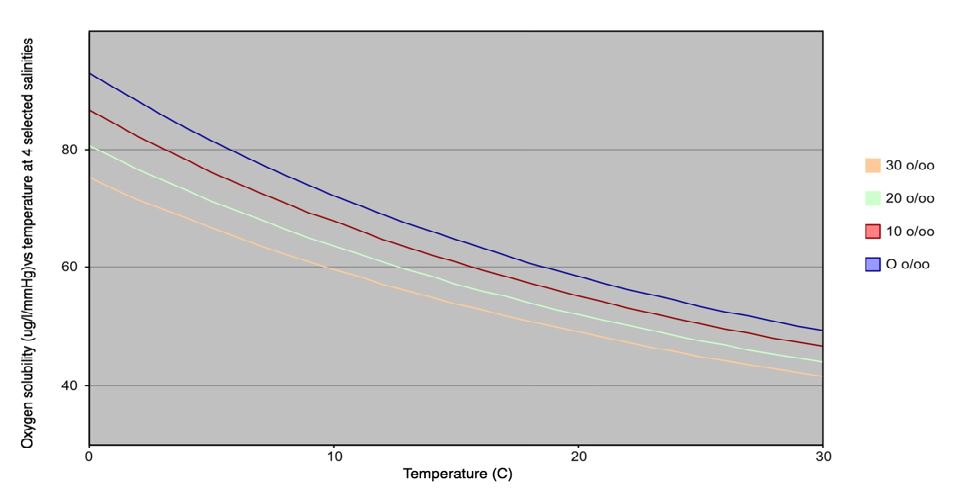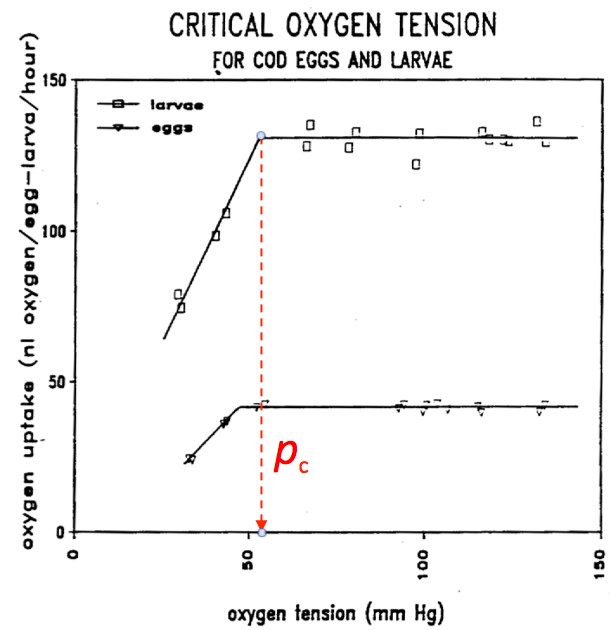For O2-uptake measurements, there are two principal designs:
Closed respirometry.
Open respirometry.
The simplest is the closed respirometer, which will be used in this exercise. A closed respirometer consists of a closed gas-tight chamber with a known volume. The fish eggs and larvae are placed (incubated) in the chamber, which is placed in a thermostated water bath to keep a constant temperature. The egg/larval oxygen uptake will cause a gradual decline in oxygen content in the water with time. The pO2 is recorded, either with continuous registration by a built-in O2-electrode (this exercise) or by taking water samples for pO2 measurements.
Oxygen solubility
Oxygen content can be quantified as the partial pressure of oxygen (PO2) expressed as i.e. mmHg taking the oxygen solubility in water at a given temperature and salinity (Figure 1), or directly as μmol/L. Based on the incubation time, the chamber volume, the oxygen solubility and the number of individuals, oxygen uptake can be calculated as nmol/ind/hr.

Chamber size
The size of the chamber should be optimized for maximum response in order to prevent excessively long test periods. Likewise, the respirometer should permit sufficient mixing of the water in the chamber to break down any O2 gradients.
The PO2 should not drop below the critical O2 tension (Pc). Pc is the tension where the fish no longer manage to regulate its O2 –consumption (Figure 2). If there is a further drop in pO2 the larvae will show a conform response, i.e. the O2-uptake will be a function of the declining pO2 into the surrounding water. Above the Pc-level, the oxygen uptake is independent of PO2.

Precautions when performing closed respirometry
The closed respirometer method is very simple and has a high level of precision. However, there are some potential negative factors. Since the system is closed, there will over time accumulate metabolic waste products (e.g. CO2, NH3) with decreasing O2 concentration. This will gradually degrade water quality, thereby increasingly affecting the metabolism of the fish. This fact can be taken into account by reducing incubation time by optimizing the size of the chamber. An advantage with continuous readings of the oxygen content is that data can be collected before the waste products reach critical levels.
Another potential problem is that the fish do not acclimatize inside the vial after the transfer, as it begins to reduce the O2 retention in the chamber once it is closed. However, with continuous readings, we can check that oxygen consumption is stable before data is sampled for analysis.
The closed respirometry method does not fully reflect a Standard Metabolic Rate. The metabolism will most likely be somewhat elevated due to stress and random swimming and is referred to as Routine Metabolism. However, since all eggs and larvae are treated the same way the data will still be satisfactory.